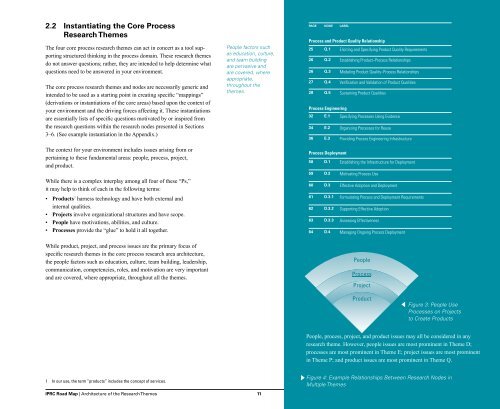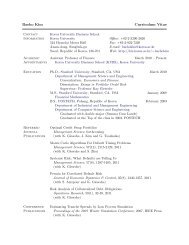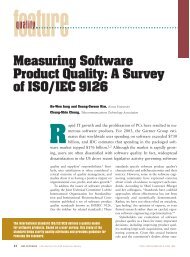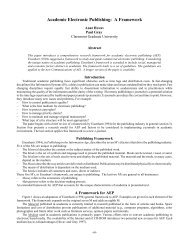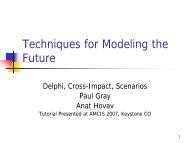A Process Research Framework - Software Engineering Institute ...
A Process Research Framework - Software Engineering Institute ...
A Process Research Framework - Software Engineering Institute ...
You also want an ePaper? Increase the reach of your titles
YUMPU automatically turns print PDFs into web optimized ePapers that Google loves.
2.2 Instantiating the Core <strong>Process</strong><strong>Research</strong> ThemesThe four core process research themes can act in concert as a tool supportingstructured thinking in the process domain. These research themesdo not answer questions; rather, they are intended to help determine whatquestions need to be answered in your environment.The core process research themes and nodes are necessarily generic andintended to be used as a starting point in creating specific “mappings”(derivations or instantiations of the core areas) based upon the context ofyour environment and the driving forces affecting it. These instantiationsare essentially lists of specific questions motivated by or inspired fromthe research questions within the research nodes presented in Sections3–6. (See example instantiation in the Appendix.)The context for your environment includes issues arising from orpertaining to these fundamental areas: people, process, project,and product.While there is a complex interplay among all four of these “Ps,”it may help to think of each in the following terms:• Products 1 harness technology and have both external andinternal qualities.• Projects involve organizational structures and have scope.• People have motivations, abilities, and culture.• <strong>Process</strong>es provide the “glue” to hold it all together.While product, project, and process issues are the primary focus ofspecific research themes in the core process research area architecture,the people factors such as education, culture, team building, leadership,communication, competencies, roles, and motivation are very importantand are covered, where appropriate, throughout all the themes.People factors suchas education, culture,and team buildingare pervasive andare covered, whereappropriate,throughout thethemes.PAGE NODE LABEL<strong>Process</strong> and Product Quality Relationship25 Q.1 Eliciting and Specifying Product Quality Requirements26 Q.2 Establishing Product–<strong>Process</strong> Relationships26 Q.3 Modeling Product Quality–<strong>Process</strong> Relationships27 Q.4 Verification and Validation of Product Qualities28 Q.5 Sustaining Product Qualities<strong>Process</strong> <strong>Engineering</strong>32 E.1 Specifying <strong>Process</strong>es Using Evidence34 E.2 Organizing <strong>Process</strong>es for Reuse36 E.3 Providing <strong>Process</strong> <strong>Engineering</strong> Infrastructure<strong>Process</strong> Deployment58 D.1 Establishing the Infrastructure for Deployment59 D.2 Motivating <strong>Process</strong> Use60 D.3 Effective Adoption and Deployment61 D.3.1 Formulating <strong>Process</strong> and Deployment Requirements62 D.3.2 Supporting Effective Adoption63 D.3.3 Assessing Effectiveness64 D.4 Managing Ongoing <strong>Process</strong> Deployment Figure 3: People Use<strong>Process</strong>es on Projectsto Create ProductsPeople, process, project, and product issues may all be considered in anyresearch theme. However, people issues are most prominent in Theme D;processes are most prominent in Theme E; project issues are most prominentin Theme P; and product issues are most prominent in Theme Q.1 In our use, the term “products” includes the concept of services.Figure 4: Example Relationships Between <strong>Research</strong> Nodes inMultiple ThemesIPRC Road Map | Architecture of the <strong>Research</strong> Themes 11


